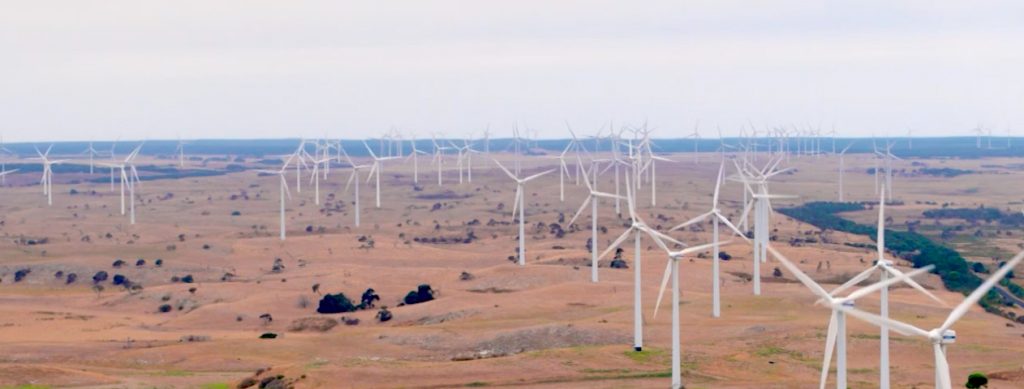Infigen to build new Tesla battery at Lake Bonney wind farm
South Australia’s wind and solar farms will be bolstered by more storage, following the announcement of a new big battery to be built at Lake Bonney in the state’s south-east.

Infigen announced the $38 million battery will be built with $5 million each from the Australian Renewable Energy Agency and the South Australian Government.
The new 25MW/52MWh battery will be built alongside Infigen’s existing 278MW Lake Bonney wind farm, which encompasses 112 wind turbines near Mount Gambier, and will be connected to the neighbouring substation.
Renewables – primarily wind – today supply more than 45 per cent of South Australia’s energy.
Finding ways to store all this energy and firm up this variable capacity has been a headline issue.
South Australia’s 100 MW Tesla battery that in part resulted from a bet between American billionaires Mike Cannon-Brookes and Elon Musk recently celebrated its first quarter of operation with data showing it has contributed to reduced energy bills and improved grid stability.
According to AEMO’s first Quarterly Report of 2018, FCAS costs dropped 57 per cent in the Hornsdale Power Reserve’s first period of operation, which the market operator attributes to the new battery and enerNOC’s demand response pilot.
Infigen’s new $38 million Lake Bonney battery will use similar Tesla technology.
Infigen Chief Executive Officer Ross Rolfe said work to install the battery will be underway on site during September.
“Construction is fairly quick. We should start to see the first power packs being energised in in early 2019,” he said.
How long to build grid-scale batteries?
Grid-scale batteries are fast to construct compared with other energy infrastructure. Infigen’s new project battery will be completed in two stages – the first 33MWh of storage is due to be installed by March 2019, with the final power packs to be in place and operational by May.
Rolfe explained that flexible, fast-response storage is a vital part of Infigen’s shift from an infrastructure fund to active electricity market participant.
“The Tesla battery will enable us to react immediately to price volatility and manage the risk around variable production in meeting our customer needs,” he said.
“When our energy market was first designed coal, gas and hydro generators dominated the plant stock. Being dispatchable, they could supply firm hedge contracts to help retailers and commercial and industrial customers manage wholesale price risks.”
This can be a challenge with wind and solar, which by their nature have variable output.
“Infigen is trying to re-inject firm hedge contracts back into the market. It’s about the combination of firming capacity with variable supply,” he said.
“With this capability Infigen will be able to expand its supply contracts from the Lake Bonney Wind Farm to additional commercial and industrial customers in South Australia, which is at the heart of our business strategy.
We will also be able to reduce our exposure to FCAS costs and respond to the impact of the five minute settlement rule when it is introduced in 2021,” Ross Rolfe said.
ARENA Chief Executive Officer Ivor Frischknecht said battery storage is becoming a key component in the transition to an energy system powered by renewables.
“It is clear that grid scale batteries have an important role to play in stabilising the grid,” he said.
“Battery storage is already making South Australia’s energy supply more secure and stable, and this project could redefine the role that renewables can perform in a competitive market,” he said.
“Co-locating the battery with a wind farm makes a lot of economic sense as key infrastructure is already in place.
“The Lake Bonney project also presents an opportunity for Infigen to pursue regulatory changes that would improve the business case for batteries co-located with renewable energy generators. Providing a financial incentive to smooth wind farm output and reduce curtailment when output is constrained would make the case for these projects even stronger,” Mr Frischknecht said.
When will Victorian big batteries come online?
Victoria’s first big batteries are due to be operational before summer, currently under construction at Gannawarra near Kerang and Ballarat in western Victoria.
ARENA and the Victorian Government have committed $25 million each towards the Victorian batteries, which ARENA CEO Ivor Frischknecht said at the announcement in March will establish Australia as a world-leader in battery storage.
Owned by Edify Energy and its partner Wirsol, the Gannawarra Energy Storage System in Northern Victoria will connect to the Gannawarra Solar Farm and deliver 25MW of electricity with 50MWh of storage. The project is the first example of a solar farm being retrofitted with battery storage.
The second battery will be built in the Ballarat suburb of Warrenheip and be charged by renewables from the region, providing 30MW of energy and 30MWh of storage.
As well as making the electricity supply more stable and secure, the batteries will support transmission lines that are becoming congested as new wind and solar farms come online.
LIKE THIS STORY? SIGN UP TO OUR NEWSLETTER

ARENA